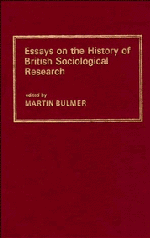Book contents
- Frontmatter
- Contents
- Preface
- Contributors
- Introduction
- History
- 2 Social monitors: population censuses as social surveys
- 3 The emergence of the sociological survey, 1887–1939
- 4 Durkheim, Booth and Yule: the non-diffusion of an intellectual innovation
- 5 The Government Social Survey
- 6 Methodological research on sample surveys: A review of developments in Britain
- 7 Mass-Observation 1937–1949
- 8 The Institute of Community Studies
- 9 Provincials and professionals: the British post-war sociologists
- 10 On the eve: a prospect in retrospect
- Use
- Index
2 - Social monitors: population censuses as social surveys
Published online by Cambridge University Press: 12 November 2009
- Frontmatter
- Contents
- Preface
- Contributors
- Introduction
- History
- 2 Social monitors: population censuses as social surveys
- 3 The emergence of the sociological survey, 1887–1939
- 4 Durkheim, Booth and Yule: the non-diffusion of an intellectual innovation
- 5 The Government Social Survey
- 6 Methodological research on sample surveys: A review of developments in Britain
- 7 Mass-Observation 1937–1949
- 8 The Institute of Community Studies
- 9 Provincials and professionals: the British post-war sociologists
- 10 On the eve: a prospect in retrospect
- Use
- Index
Summary
The population census is nowadays a taken for granted element of national social statistics. But the 1801 Census was undertaken only after a debate that had run for fifty years. The controversy consisted primarily of a debate on whether the population of England and Wales was declining or increasing, but ran into a debate on the political dangers of conducting, and publishing, such a detailed account of the whole population (Glass, 1973). Despite precedents elsewhere in Europe, the first bill to propose a census was unsuccessful in 1753, and it was not until 1800 that Parliament authorised such a major survey. The 1801 Census was the first national survey of the socio-economic characteristics of the population and preceded the surveys of Booth and Rowntree by almost a century.
The development of the British census
The earliest censuses (1801–31) took the form of simple head-counts, with the census enumerator responsible for recording the number of people and families at each address by sex and family occupation. Self-completion forms were first issued to households in 1841, so this is regarded as the first modern census in allowing for individual enumeration.
- Type
- Chapter
- Information
- Essays on the History of British Sociological Research , pp. 39 - 51Publisher: Cambridge University PressPrint publication year: 1985
- 3
- Cited by



